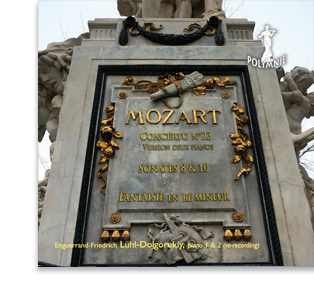 |
|||||

Wolfgang
Amadeus Mozart
Enguerrand-Friedrich
Lühl-Dolgorukiy, piano
POL 111 120

Wolfgang Amadeus Mozart
Concerto en La Majeur K. 488 n°23*
Allegro
Adagio
Allegro assai
Sonate en Do Majeur K. 330/330h n°10
Allegro moderato
Andante cantabile
Allegretto
Sonate en la mineur K. 310/300d n°8
Allegro maestoso
Andante cantabile con espressione
Presto
Fantaisie en ré mineur K. 397/385g n°3
*Enguerrand-Friedrich Lühl-Dolgorukiy, piano 1
& 2
(re-recording)
Depuis au moins 30 ans, Lühl n’a cessé de penser à réaliser son rêve le plus cher : enregistrer le Concerto en la Majeur K. 488 (n°23) pour deux pianos. Dès l’âge de 10 ans, il commença une transcription de la partie orchestrale, mais devant l'ampleur de la tâche pour un si jeune âge, le projet fut abandonné et mis de côté. Ce n’est qu’aujourd’hui, à l’ère technologique du procédé révolutionnaire du ré-enregistrement, qu’il a pu être capable de terminer son projet en enregistrant les deux parties seul, et en ajoutant sa marque de compositeur en composant la cadence du premier mouvement dans le style de Mozart.
Sonate en Do Majeur K. 330/330h (n°10)
La Sonate en Do Majeur K. 330/330h (n°10) est l’une des trois pièces d’un cycle de sonates (K.300 à 332). L’œuvre est considérée comme l’une des plus populaires de son auteur et fut même utilisée dans le film Sparky’s Magic Piano. La sonate fut composée en 1783 à l’âge de 27 ans et publiée, ensemble avec les deux autres sonates du cycle, par l’éditeur Artaria en 1784.
Sonate en la mineur K. 310/300d (n°8)
En revanche, la Sonate en la mineur K. 310/300d (n°8) fut composée en 1778 et il est intéressant de noter que Mozart n’a écrit que deux sonates en mineur (l’autre étant celle en do mineur K. 457). Durant cette période qui vit sa mère décéder, son père Léopold l’accusa d’y avoir contribué. Mozart était déchiré et c’est peut-être une des raisons pour lesquelles l’œuvre débute avec une telle fougue et une telle nervosité.
Fantaisie en ré mineur K. 397/385g (n°3)
La Fantaisie en ré mineur K. 397/385g (n°3) fut écrite en 1782. Bien qu’elle restât incomplète à la mort de Mozart, cette pièce entra dans le répertoire pianistique et devint l’une de ses pièces les plus populaires. Le manuscrit original n’a pas survécu et les dernières mesures furent perdues. C’est pour cela que la fin aurait été composée par August Eberhard Müller (1767- 1817), un élève de Johan Christoph Bach, organiste et chef de chœur. (Hirsch, Paul, "A Mozart Problem", Music and Letters 25 (4), 1944. pp. 209–12)
For at least 30 years, Lühl has waited for the occasion to fulfill one of his dearest dreams: to record Wolfgang Gottlieb Mozart’s Piano Concerto K. 488 in A Major (#23) for two pianos. Already at age 10, he started a transcription of the orchestral part, but due to lack of motivation, the project was left aside. Now, thanks to the modern era of technology and the revolutionary re-recording process, he was able to make his dream come true by transcribing and recording the entire work alone, while at the same time adding his small mark as a respectful composer by writing the first movement’s cadenza in Mozart’s genuine style.
Sonata in C Major K. 330/330h (#10)
Mozart's Piano Sonata in C Major K. 330/300h (mostly referred to as #10 by the publishers) is one of the three works in the cycle of piano sonatas K.330-332. The work is considered one of Mozart's most popular piano sonatas, and has been featured in classical music-related films, such as Sparky's Magic Piano. The sonata was composed in 1783, when Mozart was twenty-seven years old. It was published, with the other two sonatas in the cycle, by Artaria in 1784. Artaria & Co. was an important publishing house for art and maps founded by Carlo Artaria (1747–1808) in 1770 in Vienna, then the capital of the Habsburg Monarchy.
Sonata in a minor K. 310/300d (#8)
Instead, his Piano Sonata in A minor K. 310/300d (mostly referred to as #8 by the publishers), was written in 1778 and consists of three movements. It is interesting to note that Mozart has only written two sonatas in a minor key, the other being c minor K. 457. During this period, his mother had just died, and his father was blaming him for his wife's death. Mozart was torn apart because of this family tragedy, which could explain the sonata’s general, gloomier mood, especially in the first movement and the finale.
Fantasia in d minor K. 397/385g (#3)
Mozart’s Fantasia in d minorK.397/385g(#3) was writtenin 1782. Despite being left incomplete at Mozart's death, the piece remains nonetheless one of his more popular compositions. The original manuscript has not survived and the final measures of the piece have been lost. The ending as it currently exists is believed to have been written by August Eberhard Müller, (born on December 13, 1767, in Nordheim, died on December, 3, 1817, in Weimar) a German composer, organist and choir leader, and foremost one of the composer's admirers. (Hirsch, Paul, "A Mozart Problem", Music and Letters 25 (4), 1944. pp. 209–12)
Lühl-Dolgorukiy's recordings are available at the music label Polymnie, for which he already recorded several works of his own, conducting an orchestra for his Fifth Symphony (POL 990 361), or playing the piano, and more recently a CD of piano pieces by S. Rachmaninoff and the Rhapsody on a theme by Paganini as well as the Second piano concerto op. 18 (POL 150 865), also several CD by John Willams, Star Wars, (POL 151 686) Harry Potter, (POL 105 109) Jurassic Park, (POL 108 115). Lühl is planning to record his entire work (about 50 CDs).
![]()
Accueil | Catalogue
| Interprètes | Instruments
| Compositeurs | CDpac
| Stages | Contact
| Liens
• www.polymnie.net
Site officiel du Label Polymnie • © CDpac • Tous droits
réservés •


